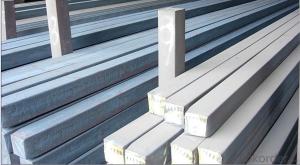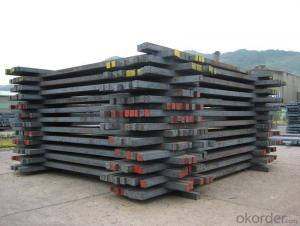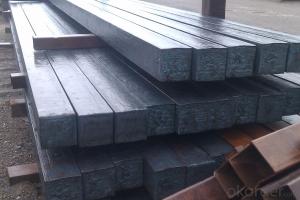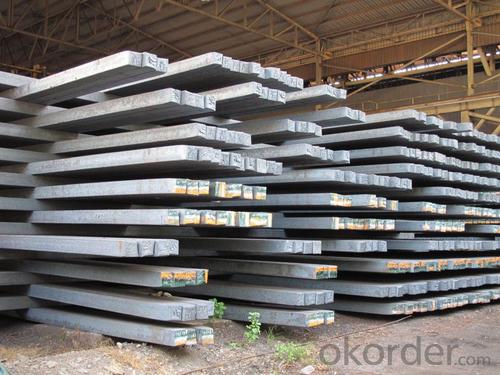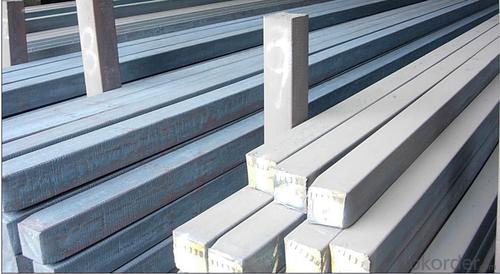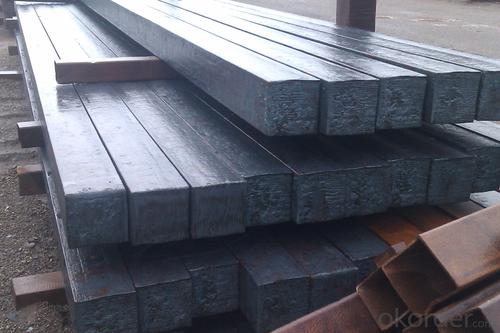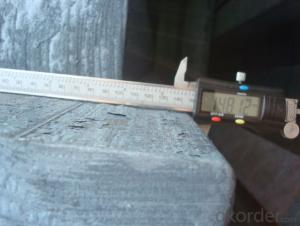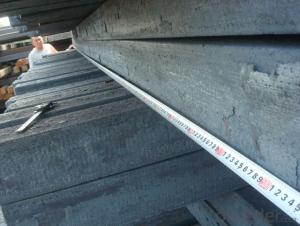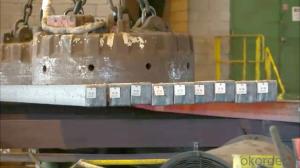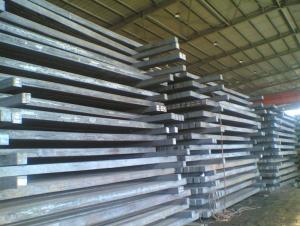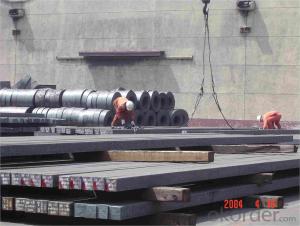Q235/3SP 115MM Blast Furnace Hot Rolled Steel Billet
- Loading Port:
- Tianjin
- Payment Terms:
- TT OR LC
- Min Order Qty:
- 2000 m.t.
- Supply Capability:
- 30000 m.t./month
OKorder Service Pledge
OKorder Financial Service
You Might Also Like
Description of Q235/3SP 115MM Blast Furnace Hot Rolled Steel Billet
Our hot dip galvanised steels consist of a steel substrate with a metallic zinc coating applied by means of a continuous hot dip galvanising process. Metallic zinc coatings are available in steel grades ranging from steel for bending and deep drawing applications, to structural steels and high yield strength steels.
A glossy surface finish obtained under specific skin-pass conditions (either non-skin-passed or skin- passed with smooth cylinders to obtain low roughness) can be provided if required at time of enquiry.
Advantage of Q235/3SP 115MM Blast Furnace Hot Rolled Steel Billet
Uncoated CR steel sheet With the features of in line with the international highest standards in demension and shape, excellent surface finish and properties, the products are mainly used in home appliance and automobile industries.
Galvanized steel sheet(include HDG and EG)
With the features of good corrosion resistance, the products are mainly used in automobile, home appliance, electronics, building and machinery manufacture industries, etc.
Precoated steel sheet With the features of enviromental protection and good processablility, long lasting surface durability, rich in colors, the products are maily used in building, home appliance and furniture industries, etc.
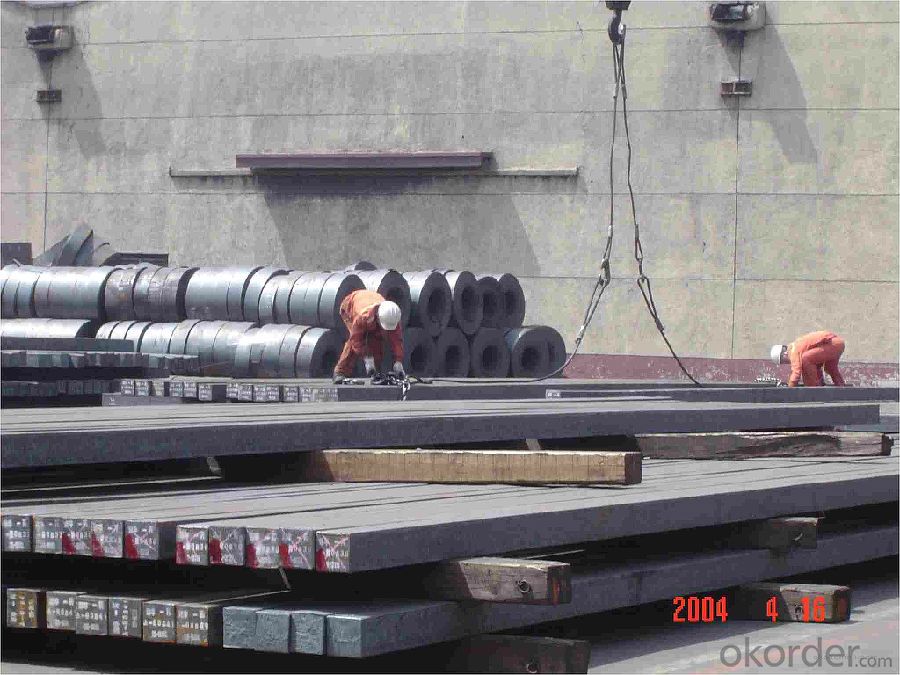
Applications of Q235/3SP 115MM Blast Furnace Hot Rolled Steel Billet
Our hot dip galvanised steels can be used in a very wide range of applications for industrial markets, both indoors and outdoors. Some of the most common applications are:
Building: wide sections for roofing and cladding, doors, door frames, metallic ceilings, partitions, structural members etc
Domestic appliances: all appliances for this sector (both white and brown goods) are manufactured with hot dip galvanised steels
Miscellaneous: electrical cabinets, aeraulic components, air conditioners, road signs etc
Zinc hot dip galvanised steel is suitable for contact with foodstuffs under certain conditions, as specified in European directive 89/109/EEC and French standard NF A 36-712-1. Please contact us for further information on this subject.
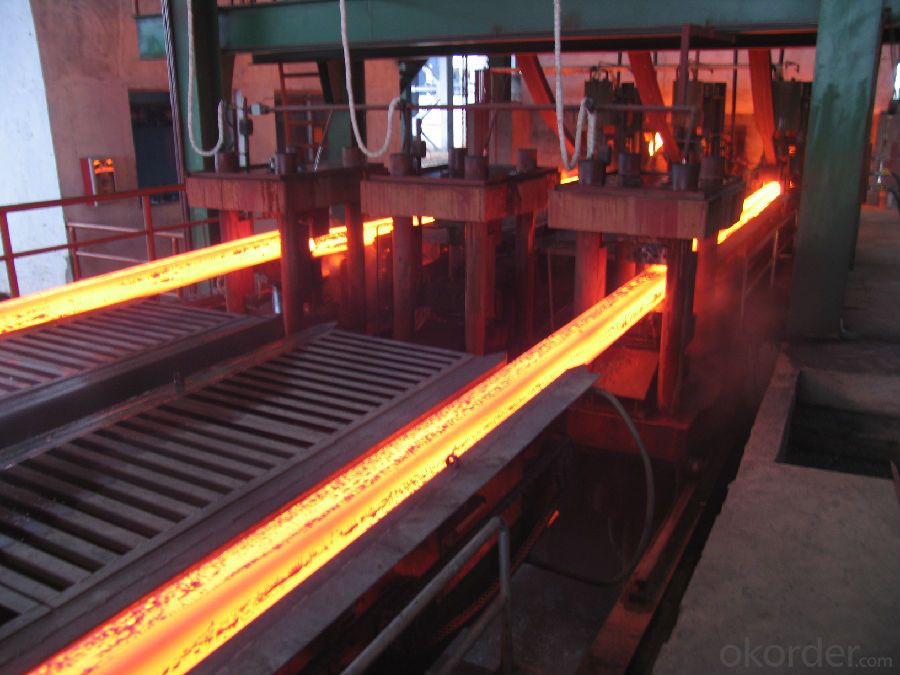
Specifications of Q235/3SP 115MM Blast Furnace Hot Rolled Steel Billet
Quality | Q/BQB 440-2003 | JIS G3312-1994 JIS G3321 | EN 10326-2004 | ASTM A653-02a |
EN 10327-2004 | (BASE PLATE) | |||
(BASE PLATE) | ||||
Commercial Steel | DC51D | SGCC SGLCC | DX51D+Z DX51D+AZ | CS Type A/B/C |
Forming Steel | St01,St02,St03 | SGCD1 SGLCD1 | FS Type A, Type B | |
Drawing | DC52D /DC53D | - | DX52D+Z DX52D+AZ | DDS TYPE A/C |
Steel | DX53D+Z DX53D+AZ | |||
Structural | S280GD (StE28) | SGC400 SGLC400 | S280D+Z DX54D+AZ | SS275 |
Steel | S350GD (StE34) | SGC440 SGLC440 | S350D+Z S350D+AZ | SS340 Class1 |
FAQ of Q235/3SP 115MM Blast Furnace Hot Rolled Steel Billet
We have organized several common questions for our clients,may help you sincerely:
1. How Can I Visit There?
Our company is located in Tianjin City, China, near Beijing. You can fly to Tianjin Airport Directly. All our clients, from home or aboard, are warmly welcome to visit us!
2. How Can I Get Some Sample?
We are honored to offer you sample.
3. Why choose CNBM?
Our delivery time about 15-20days for standard sizes, if you have other requirements like hardness, quanity and width ,it is about 20-40days. But don't worry we also try our best for the delivery time ,because time longer and our cost is higher.
- Q: What are the main factors that affect the availability of steel billets?
- The main factors that affect the availability of steel billets include the demand and consumption patterns in the steel industry, the production capacity and efficiency of steel mills, fluctuations in raw material prices, government policies and regulations, and global economic conditions.
- Q: How long do steel billets last?
- Steel billets can last for a very long time, depending on various factors such as their storage conditions and usage. Generally, if steel billets are stored properly in a controlled environment with low humidity and protected from corrosion, they can last indefinitely. However, if they are exposed to harsh weather conditions, excessive moisture, or corrosive substances, their lifespan can be significantly reduced. In terms of usage, steel billets are typically melted down and used to produce other steel products, such as bars, rods, and beams. The lifespan of the final product will depend on its specific application and the maintenance practices employed. Generally, steel products are known for their durability and longevity, making them a reliable choice in various industries.
- Q: What are the specifications for stainless steel billets used in the marine industry?
- Stainless steel billets used in the marine industry must adhere to specific specifications to ensure optimal performance and durability in harsh marine environments. These specifications typically include the following: 1. Material Composition: Stainless steel billets for marine applications are usually made from austenitic stainless steel grades such as 304, 316, or 316L. These grades offer excellent corrosion resistance, high strength, and good weldability. 2. Corrosion Resistance: The stainless steel billets must have high resistance to corrosion caused by saltwater, moisture, and other aggressive marine elements. They should exhibit excellent resistance to pitting, crevice corrosion, and chloride-induced stress corrosion cracking. 3. Mechanical Properties: The billets should possess sufficient tensile strength, yield strength, and elongation to withstand the demanding conditions encountered in the marine industry. These properties ensure that the stainless steel can handle the heavy loads, vibrations, and impacts experienced at sea. 4. Heat Treatment: Proper heat treatment processes, such as annealing, may be required to enhance the stainless steel's mechanical properties and corrosion resistance. Heat treatment can also eliminate residual stresses and improve the material's toughness. 5. Surface Finish: The surface of the billets should be free from defects, such as cracks, pits, and inclusions, which could compromise the structural integrity or promote corrosion. A smooth, polished surface is often desired to minimize friction and facilitate easier cleaning. 6. Dimensional Tolerance: Stainless steel billets used in the marine industry must adhere to specific dimensional tolerances to ensure compatibility with other marine components and facilitate ease of manufacturing and assembly. 7. Certification: Billets for the marine industry may need to meet various certification standards, such as ASTM, ISO, or specific industry standards like the American Bureau of Shipping (ABS) or Det Norske Veritas Germanischer Lloyd (DNV-GL) certifications. These certifications ensure that the stainless steel meets the required quality and safety standards. Overall, the specifications for stainless steel billets used in the marine industry focus on corrosion resistance, mechanical properties, heat treatment, surface finish, dimensional tolerances, and adherence to relevant certifications. These specifications ensure that the stainless steel billets can withstand the harsh marine environment, prolonging the lifespan of marine structures and components.
- Q: What are the causes of internal cracks in continuous casting billet?
- The test according to the process of the sample for cooling, in order to study the effects of the three elements of the internal crack of continuous casting billet hot.
- Q: What is the standard size of a steel billet?
- The standard size of a steel billet can vary depending on its intended use and industry standards. However, common sizes range from 5 inches by 5 inches to 10 inches by 10 inches, with varying lengths.
- Q: What are the different types of steel billet cutting tools?
- There are several types of steel billet cutting tools, including circular saws, band saws, abrasive saws, and torches.
- Q: How are steel billets recycled?
- Steel billets undergo the process of steel billet recycling, wherein they are collected from different sources like manufacturing plants, construction sites, and scrap yards. These collected billets are then transported to a recycling facility where they go through a series of steps to become new steel products. The initial step in steel billet recycling involves sorting and cleaning. The collected billets are sorted based on their size, shape, and quality, and any impurities or foreign materials are eliminated during this stage. Once the billets are sorted and cleaned, they are prepared for the next step in the recycling process. The subsequent step is melting, in which the cleaned steel billets are melted down in a furnace at extremely high temperatures. This melting process helps in separating any remaining impurities and enables the steel to be shaped into new forms. The molten steel is then poured into molds or cast into different shapes according to the desired end product. Once the steel has cooled and solidified, it undergoes further processing to achieve the desired specifications. This may include rolling, forging, or extruding the steel billets to create various steel products like bars, rods, or sheets. These newly formed steel products are then thoroughly inspected for quality and undergo rigorous testing to ensure they meet industry standards. The final step in steel billet recycling is distribution and usage. The recycled steel products are transported to various industries such as construction, automotive, or manufacturing, where they are utilized to create a wide range of products. By recycling steel billets, we can reduce the demand for raw materials, conserve energy, and minimize environmental impact. In conclusion, the process of steel billet recycling involves sorting, cleaning, melting, shaping, and distributing. This recycling process allows us to reuse steel billets and transform them into new steel products, thereby contributing to a more sustainable and environmentally friendly approach to steel production.
- Q: What are the potential applications of steel billets in the automotive sector?
- The automotive sector benefits greatly from the versatility of steel billets. These billets play a vital role in producing automotive parts and components. They can be processed and shaped into rods, bars, and sheets to create essential components like engine parts, chassis, and suspension systems. The strength and durability of steel make it an ideal material for automotive applications. By transforming steel billets into high-strength steel alloys, we can harness their exceptional mechanical properties, including high tensile strength, hardness, and impact resistance. These properties are crucial for structural components like vehicle frames and bodies, providing stability and enhancing passenger safety. Engine parts such as crankshafts, camshafts, and connecting rods also benefit from the strength and resistance to wear and fatigue that steel billets offer. Gears, axles, and transmission components, which face demanding conditions in the automotive industry, require excellent mechanical properties that steel billets can provide. Steel billets are also instrumental in manufacturing suspension systems, including control arms, stabilizer bars, and springs. These components must withstand heavy loads, vibrations, and impacts while ensuring optimal ride comfort and handling. Steel billets' high strength and toughness make them well-suited for these critical suspension components. Moreover, steel billets find application in the production of safety features in automobiles. For instance, they can be used to manufacture reinforced door beams, which improve the vehicle's structural integrity and provide protection in the event of a collision. Seat frames and seatbelt components also benefit from the use of steel billets, ensuring passenger safety and restraint systems. In conclusion, the vast and essential applications of steel billets in the automotive sector cannot be overstated. Their strength, durability, and excellent mechanical properties make them indispensable for producing a wide range of automotive components, including engine parts, structural elements, and safety features.
- Q: What are the potential applications of steel billets in the oil and gas aftermarket?
- Steel billets possess a wide range of potential uses within the oil and gas aftermarket. Initially, they find application in the production of various components for the industry, including valves, flanges, and fittings. These components are indispensable for the efficient functioning and upkeep of pipelines, refineries, and drilling facilities. Moreover, steel billets serve a critical role in the manufacturing of seamless pipes, which are essential for the long-distance transportation of oil and gas. The seamless pipes crafted from steel billets exhibit exceptional strength, durability, and resistance to corrosion, rendering them suitable for the often challenging conditions encountered in the oil and gas industry. Furthermore, steel billets find utility in the production of downhole tools and equipment. These tools are instrumental during drilling operations, enabling the extraction of oil and gas from beneath the Earth's surface. Steel billets provide the necessary strength and toughness to withstand the extreme pressures and temperatures encountered in downhole environments. Additionally, steel billets contribute to the fabrication of storage tanks and vessels utilized in the oil and gas industry. These tanks serve as storage facilities for crude oil, refined products, and natural gas. Steel billets offer exceptional weldability and structural integrity, guaranteeing the reliability and safety of these storage facilities. Moreover, steel billets find application in the construction of offshore platforms and structures. These platforms are integral to drilling, production, and processing activities in offshore oil and gas fields. Steel billets are highly favored in this context due to their outstanding strength, resistance to corrosion, and ability to withstand the harsh marine environment. In conclusion, the potential uses of steel billets within the oil and gas aftermarket are extensive. Whether it is the production of components, seamless pipes, and downhole tools, or the fabrication of storage tanks and offshore platforms, steel billets play a crucial role in supporting the operations of the oil and gas industry.
- Q: What is the role of steel billets in the manufacturing of automotive transmission systems?
- The manufacturing of automotive transmission systems heavily relies on steel billets, which serve as essential raw material forms of steel. These billets act as the foundation for shaping and forming various components of the transmission system. The production of gears, shafts, and other critical transmission components is one of the primary purposes of steel billets in the manufacturing process. These billets are either forged or machined to achieve the desired shape, strength, and dimensional accuracy necessary for these components. By utilizing steel billets, manufacturers ensure that these parts possess the required strength, durability, and resistance to wear and tear, which are crucial for the proper functioning of the transmission system. Additionally, steel billets also find application in the manufacturing of transmission casings. These casings serve as protective housing for the internal components of the transmission system. To create these casings, steel billets are cast or molded into the desired shape, guaranteeing that they possess the necessary strength and rigidity to withstand the forces and stresses experienced by the transmission system. Furthermore, the use of steel billets allows for the customization and optimization of transmission system components. Manufacturers have the freedom to select specific grades of steel billets based on their desired properties, such as hardness, toughness, or corrosion resistance. This flexibility enables the production of transmission systems that meet the specific requirements of different automotive applications, whether it involves high-performance vehicles or heavy-duty trucks. In conclusion, steel billets play a vital role in the manufacturing of automotive transmission systems. They provide the raw material needed to create gears, shafts, casings, and other components. Steel billets ensure the strength, durability, and customization potential necessary to produce reliable and efficient transmission systems for various automotive applications.
Send your message to us
Q235/3SP 115MM Blast Furnace Hot Rolled Steel Billet
- Loading Port:
- Tianjin
- Payment Terms:
- TT OR LC
- Min Order Qty:
- 2000 m.t.
- Supply Capability:
- 30000 m.t./month
OKorder Service Pledge
OKorder Financial Service
Similar products
Hot products
Hot Searches
Related keywords

